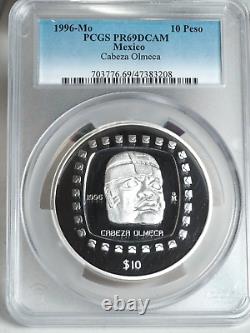1996, Mexico. Proof Silver 10 Pesos 5 Oz Coin. 3,550 pcs! Top Pop! PCGS PR69DC



Proof Silver 10 Pesos 5 Oz Coin. Mint Year: 1996 Reference: KM-? Mint Place: Mexico (Mo) Denomination: 10 Pesos - Cabeza Olmeca. Certified and graded by PCGS as PR-69 Deep Cameo!
999 Weight: 155.51gm Diameter: 65mm. The Olmec colossal heads are stone representations of human heads sculpted from large basalt boulders. They range in height from 1.17 to 3.4 metres (3.8 to 11.2 ft).
The heads date from at least 900 BC and are a distinctive feature of the Olmec civilization of ancient Mesoamerica. All portray mature individuals with fleshy cheeks, flat noses, and slightly-crossed eyes; their physical characteristics correspond to a type that is still common among the inhabitants of Tabasco and Veracruz. The backs of the monuments often are flat. The boulders were brought from the Sierra de Los Tuxtlas mountains of Veracruz. Given that the extremely large slabs of stone used in their production were transported over large distances over 150 kilometres (93 mi), requiring a great deal of human effort and resources, it is thought that the monuments represent portraits of powerful individual Olmec rulers. Each of the known examples has a distinctive headdress. The heads were variously arranged in lines or groups at major Olmec centres, but the method and logistics used to transport the stone to these sites remain unclear.They all display distinctive headgear and one theory is that these were worn as protective helmets, maybe worn for war or to take part in a ceremonial Mesoamerican ballgame. The discovery of the first colossal head at Tres Zapotes in 1862 by José María Melgar y Serrano was not well documented nor reported outside of Mexico. The excavation of the same colossal head by Matthew Stirling in 1938 spurred the first archaeological investigations of Olmec culture. Seventeen confirmed examples are known from four sites within the Olmec heartland on the Gulf Coast of Mexico. Most colossal heads were sculpted from spherical boulders but two from San Lorenzo Tenochtitlán were re-carved from massive stone thrones.
An additional monument, at Takalik Abaj in Guatemala, is a throne that may have been carved from a colossal head. This is the only known example from outside the Olmec heartland. Dating the monuments remains difficult because of the movement of many from their original contexts prior to archaeological investigation. The smallest weigh 6 tons, while the largest is variously estimated to weigh 40 to 50 tons, although it was abandoned and left uncompleted close to the source of its stone.
Mexico, officially the United Mexican States, is a federal constitutional republic in North America. It is bordered on the north by the United States of America; on the south and west by the Pacific Ocean; on the southeast by Guatemala, Belize, and the Caribbean Sea; and on the east by the Gulf of Mexico.
Covering almost two million square kilometres (over 760,000 sq mi), Mexico is the fifth largest country in the Americas by total area and the 13th largest independent nation in the world. With an estimated population of over 113 million, it is the world's eleventh most populous country and the most populous Spanish-speaking country.
Mexico is a federation comprising thirty-one states and a Federal District, the capital city.


